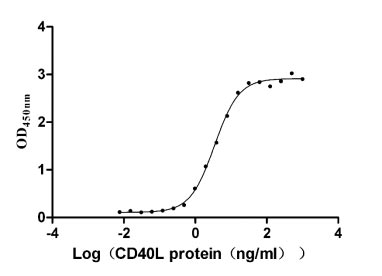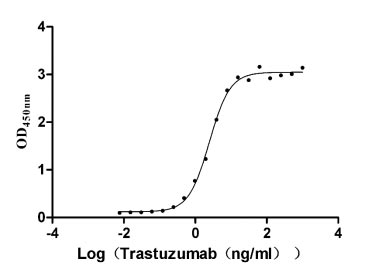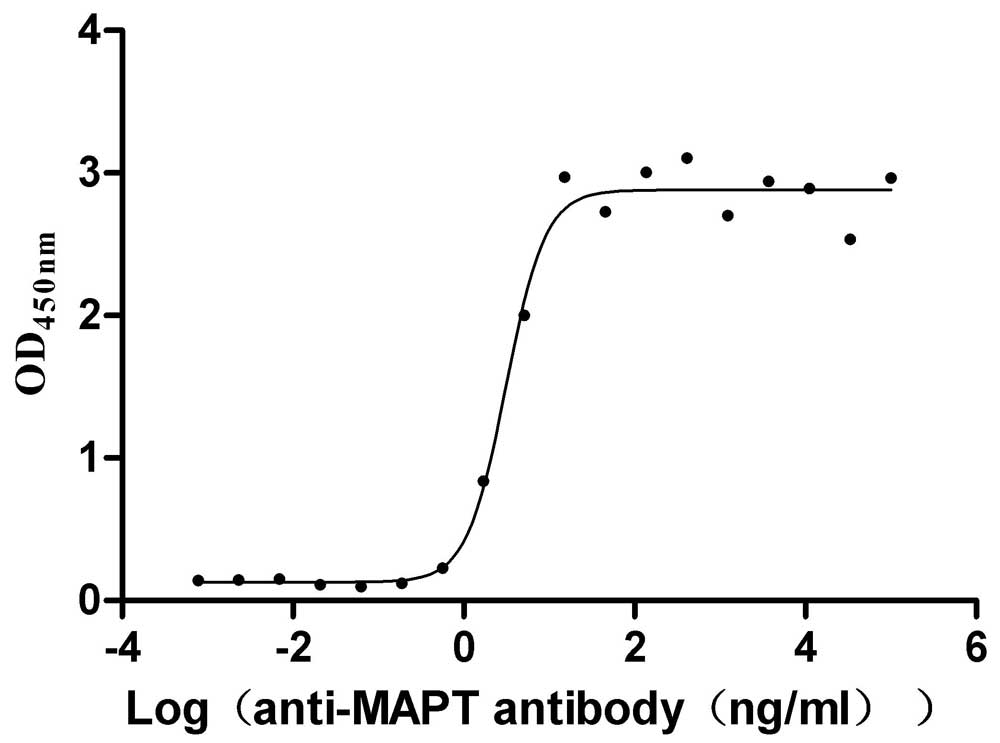Recombinant Human Tumor susceptibility gene 101 protein (TSG101), partial
In Stock Promotion-
货号:CSB-EP860355HU1
-
规格:¥1836
-
促销:

-
图片:
-
其他:
产品详情
-
纯度:Greater than 85% as determined by SDS-PAGE.
-
基因名:
-
Uniprot No.:
-
别名:ESCRT I complex subunit TSG101; ESCRT-I complex subunit TSG101; TS101_HUMAN; TSG 10; TSG 101; TSG10; Tsg101; Tumor susceptibility 101; Tumor susceptibility gene 10; Tumor susceptibility gene 101; Tumor susceptibility gene 101 protein; Tumor susceptibility protein; Tumor susceptibility protein isoform 3; VPS 23; VPS23
-
种属:Homo sapiens (Human)
-
蛋白长度:Partial
-
来源:E.coli
-
分子量:36.6 kDa
-
表达区域:1-145aa
-
氨基酸序列MAVSESQLKKMVSKYKYRDLTVRETVNVITLYKDLKPVLDSYVFNDGSSRELMNLTGTIPVPYRGNTYNIPICLWLLDTYPYNPPICFVKPTSSMTIKTGKHVDANGKIYLPYLHEWKHPQSDLLGLIQVMIVVFGDEPPVFSRP
Note: The complete sequence including tag sequence, target protein sequence and linker sequence could be provided upon request. -
蛋白标签:N-terminal 10xHis-SUMO-tagged and C-terminal Myc-tagged
-
产品提供形式:Liquid or Lyophilized powder
Note: We will preferentially ship the format that we have in stock, however, if you have any special requirement for the format, please remark your requirement when placing the order, we will prepare according to your demand. -
缓冲液:Tris-based buffer,50% glycerol
-
储存条件:Store at -20°C/-80°C upon receipt, aliquoting is necessary for mutiple use. Avoid repeated freeze-thaw cycles.
-
保质期:The shelf life is related to many factors, storage state, buffer ingredients, storage temperature and the stability of the protein itself.
Generally, the shelf life of liquid form is 6 months at -20°C/-80°C. The shelf life of lyophilized form is 12 months at -20°C/-80°C. -
货期:3-7 business days
-
注意事项:Repeated freezing and thawing is not recommended. Store working aliquots at 4°C for up to one week.
-
Datasheet & COA:Please contact us to get it.
相关产品
靶点详情
-
功能:Component of the ESCRT-I complex, a regulator of vesicular trafficking process. Binds to ubiquitinated cargo proteins and is required for the sorting of endocytic ubiquitinated cargos into multivesicular bodies (MVBs). Mediates the association between the ESCRT-0 and ESCRT-I complex. Required for completion of cytokinesis; the function requires CEP55. May be involved in cell growth and differentiation. Acts as a negative growth regulator. Involved in the budding of many viruses through an interaction with viral proteins that contain a late-budding motif P-[ST]-A-P. This interaction is essential for viral particle budding of numerous retroviruses. Required for the exosomal release of SDCBP, CD63 and syndecan. It may also play a role in the extracellular release of microvesicles that differ from the exosomes.
-
基因功能参考文献:
- this is the first study that implicates the importance of TSG101 in anoikis resistance of thyroid cancer. PMID: 30343281
- In LNCaP prostate cancer cells, TSG101 overexpression recruits the androgen receptor (AR) to TSG101-containing cytoplasmic vesicles resulting in reduced AR protein level and AR transactivation activity downregulation. Immunofluorescence microscopy demonstrated that TSG101-decorated cytoplasmic vesicles are associated with late endosomes/lysosomes. PMID: 29859188
- The s provide evidence that the ubiquitin (Ub) E2 variant domain of Tsg101 provides chaperone function to HIV-1 Gag that is independent of its interaction with the Pro-Thr-Ala-Pro motif, supporting the hypothesis that the domain provides a function in addition to its well-established role in cellular endosomal sorting complex required for transport factor recruitment. PMID: 29123089
- In this review, HIV-infected cells have TSG101 on their surface and thus can be used in antibody-based therapies. The development of a monoclonal antibody CB8-2 lessens the assembly of viruses from infected cells PMID: 29199609
- Results indicate that Vpr overcomes the effects of TSG101 overexpression to support viral production by competing with TSG101 to bind Gag. PMID: 27648839
- our studies reveal that Tsg101 plays a role in the trafficking of macropinocytosed Kaposi's sarcoma-associated herpesvirus in the endothelial cells PMID: 27764233
- Knockdown of LAMP2A, a CMA-related protein, and TSG101, an mA-related protein, significantly but only partially decreased the punctate accumulation of GAPDH-HT in AD293 cells and primary cultured rat cortical neurons. PMID: 27377049
- the variant alleles of TSG101 rs2292179 and ATF2 rs3845744 were associated with a reduced risk of breast cancer, particularly for subjects with BMI <24 (kg/m(2)) and postmenopausal women, respectively PMID: 26729199
- TSGDelta154-1054 splice variant increases TSG101 oncogenicity by inhibiting its E3-ligase-mediated proteasomal degradation. PMID: 26811492
- Results show that TSG101 bidirectionally modulates cell invasion through regulating MMP-9 mRNA expression in different cell types. PMID: 26608825
- TSG101 plays an important role in the development of hepatocellular carcinoma PMID: 26537625
- Expression of tsg101 mRNA and of TSG101 protein were significantly higher in the oxaliplatin resistant cell line than parent HT-29 cels. PMID: 26400331
- PSAP motif of OFR3 is required for hepatitis E virus exit and interaction with host TSG101. PMID: 26457367
- Stress-internalized EGFR is retained intracellularly by continued p38 activity in a mechanism involving ubiquitin-independent, ESCRT/ALIX-dependent incorporation onto intraluminal vesicles (ILVs) of MVBs PMID: 26066081
- Tsg101 is necessary for the efficient transport and release of nucleocapsids in marburg virus-infected cells PMID: 25330247
- our findings strongly suggest that TSG101 is a cellular target for HSV-1 tegument ubiquitin specific protease activity during infection. PMID: 25510868
- Our findings thus indicate that TSG101 regulation of p21 is an important factor in the cellular function of TSG101. PMID: 24244542
- The ESCRT component TSG101 is required for optimal Human papillomavirus 16 infection. PMID: 25010273
- These data support the interferon-induced generation of a Tsg101- and ISG15-dependent checkpoint in the secretory pathway that compromises influenza virus release. PMID: 24237697
- s describe a novel compound (compound 0013) that blocks the JUNV Z-Tsg101 interaction and inhibits budding of virus-like particles. PMID: 24522922
- Knock down of TSG101 causes the EGFR to accumulate in low density endosomes. PMID: 23933150
- Data indicate tht n the Biaka, strong signal of selection was detected at CUL5 and at TSG101. PMID: 23217182
- These results support a model in which both HIV-1 Gag-induced membrane curvature and Gag-ESCRT interactions promote tetherin recruitment, but the recruitment level achieved by the former is sufficient for full restriction. PMID: 23408603
- The results provide evidence for a two-step splicing pathway of the TSG101 mRNA in which the initial constitutive splicing removes all 14 authentic splice sites, thereby bringing the weak alternative splice sites into close proximity. PMID: 22675076
- The expression of TSG101 in HCC is higher than that in corresponding non-cancer tissues and the expression level is closely correlated with TNM stage and metastasis of HCC. PMID: 22768867
- identified TSG101 as a novel FIP4-binding protein, which can also bind FIP3. alpha-helical coiled-coil regions of both TSG101 and FIP4 mediate the interaction with the cognate protein PMID: 22348143
- Overexpression of PEG10 and TSG101 was detected in gallbladder adenocarcinoma. PMID: 21455631
- Depletion of endogenous Tsg101 by siRNA led to a significant reduction of HEV release in cultured cells. PMID: 21880841
- HIV-1 infection affects the expression of host factors TSG101 and Alix PMID: 21528537
- TSG101 knockdown in breast cancer cells induces apoptosis and inhibits proliferation. TSG101 may play a biological role through modulation of the MAPK/ERK signaling pathway in breast cancer. PMID: 21117030
- TSG101 may induce the malignant phenotype of cells. PMID: 19787439
- Taken together, these data indicate that Marburg virus nucleoprotein enhances budding of virus-like particles by recruiting Tsg101 to the VP40-positive budding site through a PSAP late-domain motif. PMID: 20504928
- Results suggest that TSG101 down-regulation in cervical cancer cells is not regulated by genetic or epigenetic events. PMID: 20372822
- show that ubiquitin recognition by TSG101 is required for cSMAC formation, T cell receptor (TCR) microcluster signal termination, TCR downregulation. PMID: 20399684
- recognize ubiquitin and act in the removal of endosomal protein-ubiquitin conjugates. PMID: 11916981
- Negative regulation of cell growth and differentiation by TSG101 through association with p21(Cip1/WAF1). PMID: 11943869
- structure and functional interactions of its binding sites PMID: 12006492
- solution structure of the UEV (ubiquitin E2 variant) binding domain of Tsg101 in complex with a PTAP peptide that spans the late domain of HIV-1 p6(Gag) PMID: 12379843
- interacts specifically with human immunodeficiency virus type 2 gag polyprotein, results in increased levels of ubiquinated gag, and is incorporated into HIV-2 virions PMID: 12388682
- Human ortholog TSG101 does not substitute VPS23 in its ability to rescue the phenotype of defective plasma membrane proteins PMID: 12725919
- truncated and full length forms of TSG101 inhibit HIV-1 budding by interacting with the p6 L domain and by disrupting the cellular endosomal sorting machinery PMID: 12743307
- the TSG101 interaction with HRS is a crucial step in endocytic down-regulation of mitogenic signaling and this interaction may have a role in linking the functions of early and late endosomes PMID: 12802020
- alternative splicing and role implicated in interaction with HIV-1 PMID: 14526201
- TSG101 activates androgen receptor-induced transcription by transient stabilization of the monoubiquitinated state PMID: 14761944
- Reduction of TSG101 protein has a negative impact on breast and prostate tumor cell growth PMID: 14991575
- molecular interactions between Daxx and TSG101 establish an efficient repressive transcription complex in the nucleus PMID: 15033475
- X-ray crystallography study of the UEV domain of TSG101 and ubquitin showed the basis for the binding recognition at high resolution. PMID: 15053872
- Tsg101 and Nedd4.1 act successively in the assembly process of HTLV-1 to ensure proper Gag trafficking through the endocytic pathway up to late endosomes where the late steps of retroviral release occur. PMID: 15126635
- TSG101 binds GR and protects the non-phosphorylated receptor from degradation. PMID: 15657031
- interaction of Gag with Tsg101 and Alix favors budding from the plasma membrane and relieves a requirement for ubiquitination by Nedd4 PMID: 15908698
显示更多
收起更多
-
亚细胞定位:Cytoplasm. Early endosome membrane; Peripheral membrane protein; Cytoplasmic side. Late endosome membrane; Peripheral membrane protein. Cytoplasm, cytoskeleton, microtubule organizing center, centrosome. Midbody, Midbody ring. Nucleus.
-
蛋白家族:Ubiquitin-conjugating enzyme family, UEV subfamily
-
组织特异性:Heart, brain, placenta, lung, liver, skeletal, kidney and pancreas.
-
数据库链接:
HGNC: 15971
OMIM: 601387
KEGG: hsa:7251
STRING: 9606.ENSP00000251968
UniGene: Hs.523512
Most popular with customers
-
Recombinant Human Tumor necrosis factor receptor superfamily member 5 (CD40), partial (Active)
Express system: Mammalian cell
Species: Homo sapiens (Human)
-
Recombinant Human Receptor tyrosine-protein kinase erbB-2 (ERBB2), partial (Active)
Express system: Mammalian cell
Species: Homo sapiens (Human)
-
Recombinant Human Leukemia inhibitory factor (LIF) (Active)
Express system: Mammalian cell
Species: Homo sapiens (Human)
-
Recombinant Macaca mulatta Microtubule-associated protein tau (MAPT) (Active)
Express system: Mammalian cell
Species: Macaca mulatta (Rhesus macaque)
-
Recombinant Human G-protein coupled receptor family C group 5 member D (GPRC5D)-VLPs (Active)
Express system: Mammalian cell
Species: Homo sapiens (Human)
-
Recombinant Human Cannabinoid receptor 1 (CNR1)-VLPs (Active)
Express system: Mammalian cell
Species: Homo sapiens (Human)
-
Recombinant Human Epithelial discoidin domain-containing receptor 1 (DDR1), partial (Active)
Express system: Mammalian cell
Species: Homo sapiens (Human)
-
Recombinant Human V-set and immunoglobulin domain-containing protein 4 (VSIG4), partial (Active)
Express system: Mammalian cell
Species: Homo sapiens (Human)





















